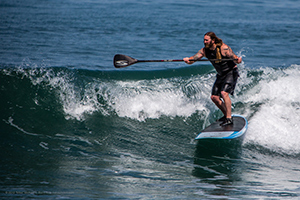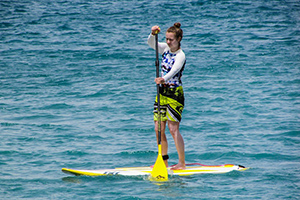Stand up paddle boarding (or SUP) is a great way to have some fun out on the water. All you need is just a few pieces of gear and a body of water. And your adventure can be as vigorous or relaxing as you want.

The great thing about paddle boarding is that it gives you a full-body workout (Isle Surf and SUP says you can burn over 1,000 calories with SUP racing), and because you’re standing while you paddle, you can see all everything around you.
You don’t have to be an athlete to enjoy stand up paddle boarding. It helps if you know how to swim and have good balance. Other than that, this is an activity that just about anyone can do.
If you’re thinking of trying stand up paddle boarding, our guide can help you get started.
SUP Gear
Paddle boarding is easy to get started with because you don’t need a whole lot of gear. Here’s what you’ll need:
SUP Board
The most important piece of equipment you’ll need is a SUP board. This will also be your biggest investment. Finding the right board can be tricky and will be based on a combination of your paddling style, size and weight.
Our beginner SUP guide can help you find the right board for your needs.
Generally, you want to choose a wider board for more stability, and a planing hull is better for beginners because it also aids in stability.
Paddle
A stand up paddle has an elbow at the shaft, which helps make it more efficient when you’re out on the water.
Paddles come in a wide range of sizes, and you’ll rarely find boards that come with paddles. Choose a model that’s 6″ to 8″ taller than you (REI actually recommends choosing a board that’s 8″ to 12″ taller) to make paddling more natural and comfortable.
Make sure that you choose a good quality paddle that won’t break or bend while you’re out on your board.
The Right Clothing
Just like any other activity, the right clothing will make a difference in your experience. The clothing you choose will depend on the weather and climate.
For cold or cool conditions, a wet or dry suit is your best option and will help prevent hypothermia. If you’re paddle boarding in the summer or in a milder climate, a bathing suit, or shorts and a t-shirt will suffice. Wear something that’s comfortable, breathable and can get wet.
Personal Floatation Device
A PFD, or personal floatation device, is crucial for safety while paddle boarding. A stand up paddle board is considered a vessel in the eyes of the U.S. Coast Guard, which means you need to wear a PFD at all times.
You can find PFDs in all shapes and sizes. Modern devices are more compact and comfortable to wear.
Leash
A leash will tether your board to you, so you don’t lose it while you’re boarding. It’s easy to lose sight and control of your board when you’re just getting started. You can and will fall several times before you get the hang of paddling.
Leashes are usually sold separately, and they come in a variety of designs for specific activities, like surfing, rivers and flatwater. Choose a leash that’s designed for your intended activity.
Sunscreen
Whether you’re paddle boarding in the middle of winter or summer (yes, you can still get sunburnt in the winter, Skin Cancer Foundation says), it’s important to protect your skin from the sun’s damaging rays. Always wear sunscreen when paddling, and if you can, wear sunglasses to protect your eyes as well.
Basic SUP Techniques
There are a few basic techniques you want to master when first getting started with paddle boarding: standing up on your board and the forward stroke.
You should also know how to hold the paddle properly. Here are some tips:
- Grip the paddle with one hand at the top and the other at the center of the shaft.
- Always hold the paddle in front of you.
- Keep your elbow bent at a 90-degree angle.
It may take a few adjustments for you to find a comfortable position when holding the paddle, but you’ll get the hang of it quickly.
Standing Up on Your Board

If this is your first time paddle boarding, Eagle Creek recommends starting out in calm and flat water. Because you’ll be falling quite a bit, you may want to wear a wet suit (unless you’re somewhere really warm).
To stand up on your board:
- Move far away enough from the shore so that your fin isn’t touching the bottom.
- Get up onto the board, and start out on your knees.
- Take a few strokes on each side of the board to get moving.
- Slowly start standing up one foot at a time.
- Stay in the middle of the board, and keep your feet parallel to the stringer.
- Your core should be centered over the board, and your knees should be slightly bent.
It may take some practice to learn how to stand up on your paddle board, but be patient and persistent.
The Forward Stroke
The forward stroke is one of the most important techniques to master. If you don’t know how to paddle properly, you’ll rely on the water to carry you and you won’t get the fully body workout you want.
There are many different ways to perform a forward stroke, but this video explains it well (plus, you get to see it in action).
Paddle boarding is a fun way to get a full-body workout while enjoying the water. Use our guide to ensure you have all of the right gear and the right techniques to get started on the right foot.

